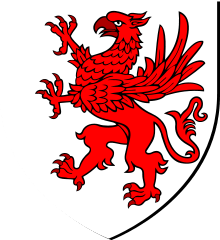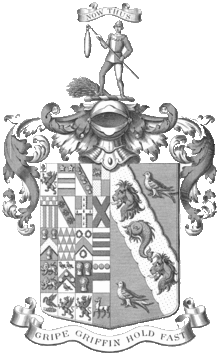De Trafford baronets
The de Trafford Baronetcy, of Trafford Park in the County Palatine of Lancaster is a title in the Baronetage of the United Kingdom.
| de Trafford baronets | |
|---|---|
 Arms of Trafford: Argent, a griffin segreant gules | |
| Creation date | 7 September 1841 |
| Monarch | Queen Victoria |
| Peerage | Baronetage of the United Kingdom |
| First holder | Sir Thomas de Trafford |
| Present holder | Sir John de Trafford |
| Heir apparent | Alexander Humphrey de Trafford |
| Remainder to | Heirs male of the body |
Background
The de Trafford family can trace their ancestry back to the 11th century.[1] The main branch was founded by Randolphus, who owned several manors in Lancashire and Cheshire. He died around 1050, sixteen years before the Norman Conquest. As with the bulk of the Anglo-Saxon lords, the family initially resisted the Norman invaders, and they defeated Hamon de Massey near Mobberley in Cheshire. However, they afterwards made peace with the Normans, and were granted a pardon. They later took the Norman-style name "de Trafford" in reference to their manor of Trafford, now part of Greater Manchester.
The 14th century was important for these manorial lords, in receiving acclaim from the Crown. Henry Trafford died in 1395, holding the manors of Trafford and Stretford, together with part of the manor of Edgeworth, and leaving a son and heir Henry, six years of age. This son died in 1408, the manors going to his brother Edmund, known as the Alchemist, from his having procured a licence from the king in 1446 authorizing him to transmute metals. Sir Edmund, at Eccles in 1411, married Alice daughter and co-heir of Sir William Venables of Bollin, and thus acquired a considerable estate in Cheshire, which descended in the Trafford family for many generations.[1]
Cecil Trafford was made a knight at Hoghton Tower in 1617. He was at first, like his grandfather, a Protestant and a persecutor, but afterwards, about 1632, became a Catholic. As a recusant family, they faced persecution and, in 1638, accordingly, the king seized a third of his estates and granted them on lease to farmers. Siding with the king on the outbreak of the English Civil War, he was seized and imprisoned by Roundheads and his estates were sequestered. His sons are mentioned as serving some of the English Interregnum at Rome and Douay. In 1653 Sir Cecil begged leave to transact under the Recusants Act relating to the sequestered two-thirds of his estates.[1]
Sir Cecil died in 1672. His eldest son Edmund died twenty years later, and was followed by a brother Humphrey, who was accused of participation in the fictitious plot of 1694, and sympathized with the rising of 1715. Around this time the family left their original home, which they occupied since 1017, moving to Whittleswick Hall, which they renamed Trafford Hall. Humphrey was succeeded by his son and grandson, also both named Humphrey. The last of these died in 1779 and was succeeded by his relative John Trafford of Croston, who died in 1815. During this time, owing to the laws concerning religion, all offices of state were closed to Catholics, who had therefore to dwell quietly on their estates.[1] The family's prospects improved after the Catholic Emancipation, and in 1841 John Trafford was created a Baronet by Queen Victoria. Sir John later obtained royal licence to change the family name from "Trafford" to "de Trafford", thus restoring it to its original mediaeval form.
Coat of arms
The arms of the family consist of a red griffin on a silver background, blazoned argent, a griffin segreant gules.[1] Their crest is a man in the act of threshing a wheatsheaf with a flail. This refers to a legend in which a member of the family escaped the Roundhead army by pretending to be a thresher. They have two mottoes: "Now Thus", and "Gripe Griffin Hold Fast".
In addition to their original family arms, the de Traffords have amassed a collection of nineteen quarterings, an unusually large amount even for an old family. The Baronet's full achievement is blazoned:
Quarterly of twenty: 1st argent, a griffin segreant gules (de Trafford); 2nd argent, two bars, and in chief two mullets pierced azure (Venables); 3rd argent, on a bend azure three garbs proper (Tritten); 4th quarterly gules and or, in the first quarter a lion passant argent (Massey); 5th paly of six argent and gules, a chief vair (Whitney); 6th argent, on a bend gules three escarbuncles sable (Thornton); 7th vert, a cross engrailed ermine (Kingsley); 8th or, a saltire sable (Hellesby); 9th azure, a chevron argent between three garbs proper (Hatton); 10th bendy barry gules and argent (Crispen); 11th argent, a chevron gules between three chaplets (Ashton); 12th argent, three bars sable (Legh); 13th gules, two lions passant guardant in pale argent (De la Mere); 14th argent, on a chevron quarterly gules and sable, between three birds of the second, as many bezants (Kitchen); 15th argent, three garbs proper banded or (Aughton); 16th argent, a fesse sable, in chief three torteaux (Mason); 17th argent, on a child proper wrapped in swaddling clothes gules, and banded or, an eagle sable (Culcheth); 18th argent, a griffin segreant azure (Culcheth); 19th argent, a griffin segreant sable ducally crowned or (Risseley); 20th azure, a hind trippant argent (Hindley). Upon the escutcheon, which is charged with his badge of Ulster as a Baronet, is placed a helmet befitting his degree, with a Mantling gules and argent; and for his Crest, upon a wreath of the colours, a thresher proper, his hat and coat per pale argent and gules, his breeches and stockings of the third and second, holding in both hands a flail or, uplifted over a garb on the dexter side, and over the crest upon an escroll the Motto, "Now Thus"; and below the arms the Motto "Gripe Griffin, Hold Fast".[2]
De Trafford baronets of Trafford Park (1841)
- Sir Thomas Joseph de Trafford, 1st Baronet (1778–1852)
- Sir Humphrey de Trafford, 2nd Baronet (1808–1886)
- Sir Humphrey Francis de Trafford, 3rd Baronet (1862–1929)
- Sir Humphrey Edmund de Trafford, 4th Baronet (1891–1971)
- Sir Rudolph Edgar Francis de Trafford, 5th Baronet (1894–1983)
- Sir Dermot Humphrey de Trafford, 6th Baronet (1925–2010)
- Sir John Humphrey de Trafford, 7th Baronet (born 1950)
Sir John's son Alexander Humphrey de Trafford (born 1978) is the heir apparent.
References
- William Farrer & J. Brownbill (editors) (1911). "Townships: Stretford". A History of the County of Lancaster: Volume 4. Institute of Historical Research. Retrieved 26 October 2013.CS1 maint: extra text: authors list (link)
William Farrer & J. Brownbill (editors) (1911). "Townships: Edgeworth". A History of the County of Lancaster: Volume 5. Institute of Historical Research. Retrieved 26 October 2013.CS1 maint: extra text: authors list (link) - Fox-Davies, Arthur (1929). Armorial Families: a Directory of Gentlemen of Coat-Armour. 1. London: Hurst & Blackett, Ltd. p. 537. Retrieved 18 August 2015.
Further reading
- Kidd, Charles, Williamson, David (editors). Debrett's Peerage and Baronetage (1990 edition). New York: St Martin's Press, 1990,
